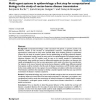Free Online Productivity Tools
i2Speak
i2Symbol
i2OCR
iTex2Img
iWeb2Print
iWeb2Shot
i2Type
iPdf2Split
iPdf2Merge
i2Bopomofo
i2Arabic
i2Style
i2Image
i2PDF
iLatex2Rtf
Sci2ools
BMCBI
2008
2008
Multi-agent systems in epidemiology: a first step for computational biology in the study of vector-borne disease transmission
Background: Computational biology is often associated with genetic or genomic studies only. However, thanks to the increase of computational resources, computational models are appreciated as useful tools in many other scientific fields. Such modeling systems are particularly relevant for the study of complex systems, like the epidemiology of emerging infectious diseases. So far, mathematical models remain the main tool for the epidemiological and ecological analysis of infectious diseases, with SIR models could be seen as an implicit standard in epidemiology. Unfortunately, these models are based on differential equations and, therefore, can become very rapidly unmanageable due to the too many parameters which need to be taken into consideration. For instance, in the case of zoonotic and vector-borne diseases in wildlife many different potential host species could be involved in the life-cycle of disease transmission, and SIR models might not be the most suitable tool to truly captur...
| Added | 08 Dec 2010 |
| Updated | 08 Dec 2010 |
| Type | Journal |
| Year | 2008 |
| Where | BMCBI |
| Authors | Benjamin Roche, Jean-François Guégan, François Bousquet |
Comments (0)

